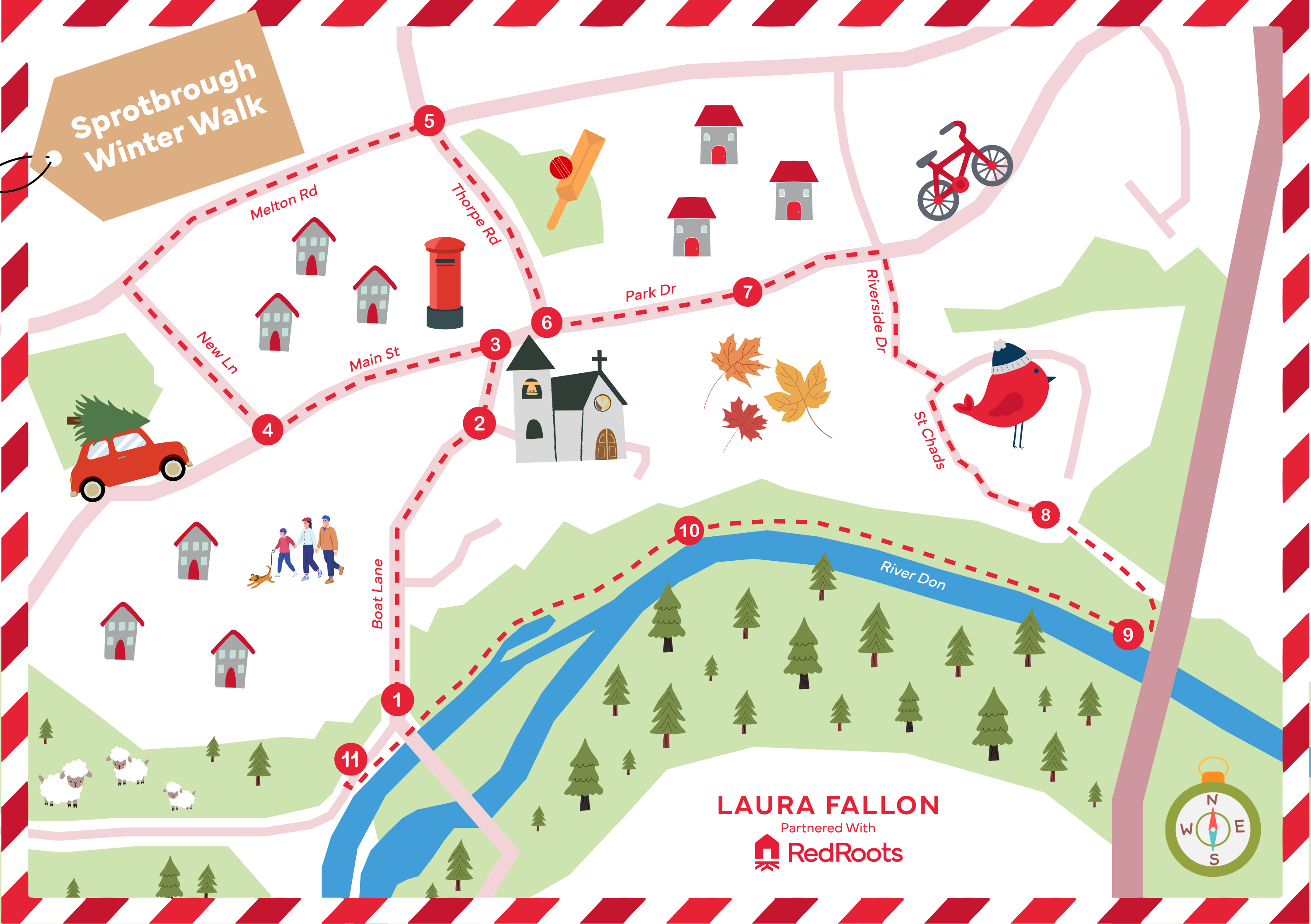
Sprotbrough Circular Walk ✨🎄
Fancy getting outdoors this winter? Get wrapped up warm and try out this Sprotbrough circular route, looking out for some interesting village history! Perfect for a dry, crisp morning in the school holidays! Plenty of places for a hot chocolate pit stop too ☕️🧣
Overview
- 2.45 miles / 3.95km
- Approx. 1 hr 15 mins (without stops)
- Mostly flat; slight woodland bumps
- Route includes: River Don, historic village features, links to Sir Walter Scott’s Ivanhoe, and the childhood home of WW2 flying ace Sir Douglas Bader
Nearest parking: Nursery Lane (next to old toll house)
1. Boat Lane Toll House
Your walk begins at the old toll house where travellers once had to stop and pay before crossing Sprotbrough Bridge. Built in 1849 for Sir Joseph Copley, it stood watch over the entrance to the village for generations. As you start up Boat Lane, the gentle climb is part of the Don Gorge itself, a landscape shaped over thousands of years by glaciers and the steady carving of the River Don far below.
2. Rectory Mews / The Old Rectory
A little further along stands the Old Rectory, quietly holding centuries of stories within its Grade II listed stonework. The old village pump, still set into the wall, features the Copley coat of arms. This peaceful spot was once home to a young Douglas Bader, who grew up to become one of Britain’s most celebrated RAF aces. From daring stunts to the horrific crash that took both his legs, and then his return to combat in WWII, the house has witnessed the early footsteps of extraordinary courage.
3. Main Street
Reaching Main Street, the village opens up in front of you. To your right, beside the red telephone box, you’ll see a set of 18th-century mounting steps, once used by riders to climb into their saddles with ease. As you continue left along the street, keep an eye out for a house with carved wooden grotesques peering from its beams, adding a hint of medieval mischief to the walk.
4. New Lane
Turning right into New Lane, you walk into the oldest chapter of Sprotbrough’s story. The village appears in the Domesday Book as Sproteburg, a small Anglo-Saxon settlement of just ten households. After the Norman Conquest, Roger de Busli, a baron who rode alongside William the Conqueror, became its new lord. One thousand years later, the line of ancient names and shifting lands still echoes in the streets you walk.
5. Thorpe Lane
Back on Melton Road, the Ivanhoe pub nods to the area’s literary link. Sir Walter Scott is said to have visited these very hills and valleys, drawing inspiration for Ivanhoe from the Don Valley and nearby Conisbrough Castle. His vivid opening lines describe the very landscape around you. As you turn down Thorpe Lane, you walk through land once held by the powerful Fitzwilliam family. Their medieval hospitality is immortalised in a stone cross that once promised weary travellers food, hay for their horses, and no questions asked. At the bottom of the lane stands St Mary’s Church, Norman in origin, reshaped many times but still holding fragments of its past, including a Saxon stone and medieval carvings.
6. Park Drive
Turning left onto Park Drive, you enter what was once the elaborate parkland of Sprotbrough Hall. The estate passed from the Fitzwilliams to the Copleys in the 1500s, and the hall was rebuilt into a grand residence by Sir Godfrey Copley by 1690. But its glory didn't last: in 1925, overwhelming death duties forced the estate to be sold and the hall eventually demolished. Yet pieces remain, old walls, proud gateposts, and the stable block, quiet reminders of a lost estate.
7. Sprotbrough Methodist Church
Keep left at the fork and you’ll reach the Methodist Church. The building you see today began its life in 1938 as a church hall, with plans to build a larger church beside it. The sycamore tree standing proudly outside was intended to be removed for the expansion, but the funds never came… and the tree stayed. Today it’s protected, now part of the church’s own story.
8. Meadow Croft
Head right down Brompton Road and follow the curve of Riverside Drive. When you turn into Meadow Croft, a quiet path leads you away from the houses and into a patch of light woodland. Just before you pass under the A1(M), a footpath draws you right and down a set of steps, guiding you towards the hush of the riverbank.
9. River Don
With the River Don flowing confidently beside you, look up through the trees on your right. Hidden among the greenery is the surviving balustrade from Sprotbrough Hall, once the edge of the grand terrace overlooking the landscape. You’re now walking the same views once enjoyed by aristocrats and baronets centuries ago.
10. Old Pumping House
Soon you’ll spot the remains of a stone building near the path. This was the Copley water pump, an impressive piece of 17th-century engineering. Driven by a waterwheel in the river, it lifted water 100 feet up the hillside to supply Sprotbrough Hall’s gardens, fountains and even a heated swimming pool. Inspired by the spectacular Emperor Fountain at Chatsworth, Sir Godfrey Copley brought a touch of grandeur to his estate, a system powerful enough to fill the pool in just five hours.
11. Return to Nursery Lane
Following the river a little farther, the path leads you beneath a bridge and gently back into the present. The walk ends where it began, at Nursery Lane, having taken you from medieval lanes and aristocratic estates to riverside woodland and wartime heroism, all within one village-sized story.

